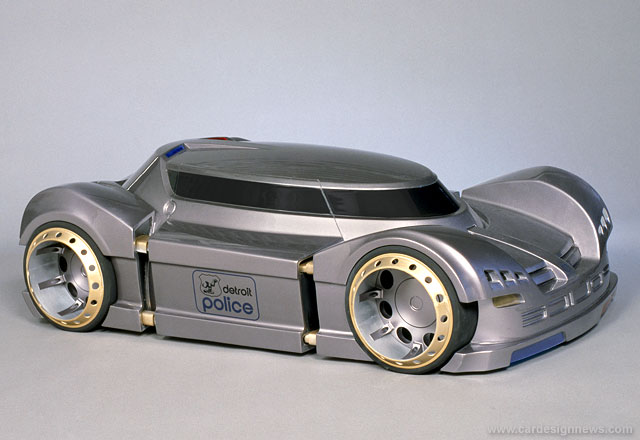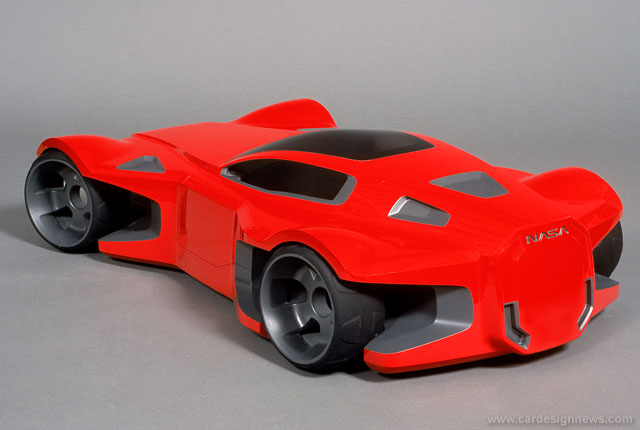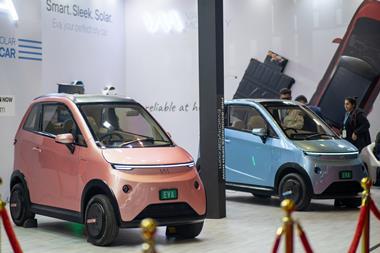Oct 25, 2004 - Transportation Design students at Detroit’s College for Creative Studies recently presented the results of a project sponsored by the American Iron and Steel Institute (AISI). The unveiling of the students’ concept vehicles is the finale of the 16th annual AISI/CCS Summer Internship Program that set the transportation design students the task of designing functional, innovative 'Hollywood-inspired' vehicles that integrate environmental responsibility, cost efficiency and innovative steel materials.
“The AISI/CCS summer internship was created to inspire a new generation of automotive designers to develop alternative fuel vehicles, lightweight steel structures and a flexible platform base, all of which are real goals for today’s automotive product developers,” said Brian Aranha, vice president of commercial for Dofasco Inc. and chairman of AISI’s Automotive Applications Committee. “While looking to Hollywood may seem an unconventional approach to vehicle design, it is meant to get these students excited about taking vehicle design to the next level.”
The AISI/CCS students Darren Chilton, Robert Jablonski, and Dan Cline embraced the challenge of creating, directing and producing the development of their own concept vehicles and drew upon a variety of influences during the process:
Darren Chilton - The Defender
Darren Chilton, 32, is majoring in industrial design and selected the film 'Robocop' as the inspiration for his concept vehicle. According to Chilton, most people associate Robocop with his armor and thus to steel and the strength and protection it provides. Applying the visual language used for Robocop, Chilton’s goal was to produce a vehicle that will express the same type of toughness and safety. The fact that Robocop is depicted in the city of Detroit adds relevance and the fact that the vehicle is portrayed in police trim aides in conveying the message of safety.
“By utilizing the newest high-strength steels and the latest innovative technologies such as laser welding, I am able to create a machine-like aesthetic while retaining the needed strength and structure of the vehicle. Using large multi-faceted panels eliminates cut-lines and reduces the number of body panels, thus reducing cost,” said Chilton. “The use of high-strength steel provides the necessary structural properties, as well as conveying the intended visual theme."
Robert Jablonski - NASA 9000
Robert Jablonski, 23, is majoring in industrial design with an emphasis on transportation design. According to Jablonski, he drew inspiration from the movie '2001: A Space Odyssey'.
"The goal of this summer's AISI/CCS internship was to push automotive design into the future by incorporating new steel technologies,” said Jablonski. “The film '2001: A Space Odyssey' is a classic movie filled with projections of the future, space travel and computers. It was an entirely new approach to filmmaking that parallels our goal of taking a new approach to automotive design using new advanced high-strength steel technologies.”
The seating design is a traditional two-seater over a corvette package with air suspension. Tubular hydro-formed steel pillars provide extra strength while advanced high-strength steel body panels reduce the overall vehicle weight. Less exposed areas of the car will reveal its high-strength steel structure. Oversize cast steel wheels will be incorporated increasing affordability and strength."
Dan Cline - 'Nazgul' (aka Ringwraith, Dark Rider)
Dan Cline, 21, recently completed his sixth semester as an industrial design student at CCS. According to Cline, a car for the movies is one that must inspire and 'push the envelope' of design. With this project, he wanted to create a vehicle that would be unforgettable.
"Much like the movie it is inspired from, ‘The Lord of the Rings,’ my concept has a very distinct visual language. Using references from the helmets, armor and overall visual cues of the Elvin world, my concept is to create a mid-drive train, single occupant sports car that combines the durability and weight-reducing capabilities of advanced high-strength steel,” said Cline. “This concept will demonstrate the extreme versatility of a vehicle that utilizes advanced high-strength steels and innovative manufacturing processes in its design."
A combination of advanced high-strength steel for the outer shell and softer steel used for the intricate detail is key to the design. The weight savings achieved by designing with advanced-high strength steel help increase fuel efficiency and permit the use of alternative fuel sources, while allowing increased creativity for the package layout. The vehicle will also takes advantage of textured steel on the exterior body panels giving the vehicle more character. The use of glass that is the same color and texture of the steel will allow for a seamless look. Large stampings and laser welding will keep the surfaces clean and the design uninterrupted."
During the AISI/CCS program, the students combined classroom and real-world experience as they developed their vehicles as digital models using Alias software, then had them formed into models by a milling specialist. “Giving talented automotive design students the opportunity to see their conceptual vehicle designs go from Alias to milled models is a valuable experience for these students,” said Bryon Fitzpatrick, chairman of the CCS Industrial Design Department. “This internship challenges students to think creatively in steel and fosters a knowledge base that will be useful throughout their automotive design careers.”
During this year’s internship, AISI organized field trips for the students to introduce them to the steelmaking and vehicle manufacturing processes. Field trips to steel mills, stamping plants, engineering facilities and design studios provide rare opportunities to witness the various production stages involved in creating a vehicle. These experiences not only broaden the students' knowledge of the automotive industry, but also technically orient them toward designing the interior and exterior surfaces of innovative contemporary vehicles.
Located in Detroit's Cultural Center, the College for Creative Studies offers Bachelor of Fine Arts degrees in animation and digital media, communication design, crafts, fine arts, illustration, industrial design, interior design and photography. CCS website: www.ccscad.edu
The American Iron and Steel Institute is a non-profit association of North American companies engaged in the iron and steel industry. The Institute comprises 30 member companies, and 118 associate and affiliate members who are suppliers to or customers of the steel industry. AISI website: www.autosteel.org

'Defender' by Darren Chilton

NASA 9000 by Robert Jablonski

'Nazgul' by Dan Cline
Now in its sixteenth season, the AISI design student summer internship program inspires students to find innovative solutions to problems they will face during their careers in transportation design. Previous CCS/AISI Summer Internship Programs have addressed the following challenges:
1989 Future Buick Reatta
Develop alternative designs for the Buick Reatta.
1990 Space Utilization
Create vehicles with more efficient space utilization and crash worthiness with special attention to side impact and incorporation of ultra-high-strength steel side impact beams.
1991 Neon Niche Vehicles
Create niche vehicles based on the Neon platform, including hydroforming technology for low tooling investment, and laser welding for improved safety and weight reduction.
1992 CNG-Powered
Create vehicles powered by compressed natural gas (CNG). This assignment explored ways of integrating fuel containers to reduce weight and improve safety, and addressed vehicle trends, particularly those of interest to the 35-and-under age group.
1993 Design of Vehicles in Steel Exploring Weight Reduction Ideas
Design vehicle bodies that are lighter in weight, maintain safety, and incorporate rigid designs using thinner gauges of steel. This project stretched the ability of designers to create fresh designs without the assistance of large glass areas or plastic moldings.
1994 City Cars
Style small, fuel-efficient “city cars” that meet government clean air mandates and are attractive to American consumers. The challenge was to meet small packaging parameters with designs that exude a perception of safety and performance.
1995 ULSAB-Style Packages
Create exterior designs for the UltraLight Steel Auto Body (ULSAB). While permitted only to add minimal changes to the body architecture, the students were challenged to create fresh-looking models within the constraints.
1996 Hybrid Propulsion
Style innovative and exciting exteriors for future hybrid propulsion system vehicles while striving for weight and cost reduction.
1997 SUV/Pickup Trucks
Design pickup trucks and sport utility vehicles (SUVs) that integrate consumer preference for sportiness, control, power and safety with the steel industry’s innovative Light Truck Structure architecture.
1998 First-Time Buyers
Create a vehicle that appeals to first-time buyers and costs less than $16,000. The vehicles leveraged steel’s high strength and low cost to meet these specifications.
1999 Celebrity Cars
Style exciting vehicles for today and tomorrow’s celebrities. Styling cues were taken from autos of Hollywood’s heyday. Unlike the previous year, the students were not constrained to a price tag.
2000 Hummer-Based Vehicles
Design steel-intensive vehicles based on the Hummer platform. Each design embraced a different market segment ranging from entry-level to mid-level to luxury-range.
2001 Interchangeable
Design steel-intensive vehicles that focus on reduced tooling costs. Objectives for each student included designing vehicles with the maximum interchangeability of body parts.
2002 Tuner Market
Research the “tuner” market and design a production vehicle that will be appealing to mass-market consumers but can be easily modified by a tuner into a one-of-a-kind vehicle.
2003 Urban Youth
Design functional, futuristic vehicles marketed to urban youth that integrate environmental responsibility, cost-efficiency and innovative steel materials.







































